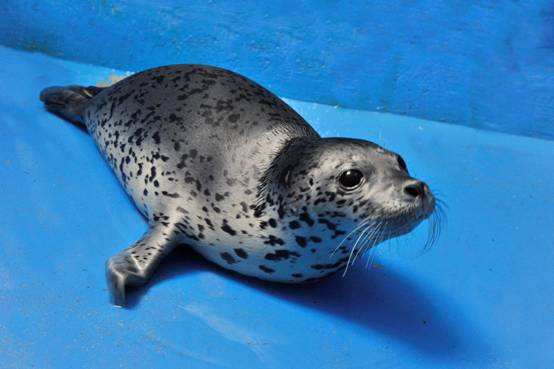Phoca largha
IUCN
LCBasic Information
Scientific classification
- name:Phoca largha
- Scientific Name:Harbor seal, seal, fur seal, fur seal, western Pacific harbor seal
- Outline:Carnivora
- Family:Carnivora Pinnipedia Phocidae Phoca
Vital signs
- length:Males are about 1.5 to 1.7 meters long; females are about 1.4 to 1.6 meters long
- Weight:Males weigh about 85 to 110 kg; females weigh about 65 to 115 kg
- lifetime:Up to 35 years
Feature
The cutest seal in the world.
Distribution and Habitat
Harbor seals are mainly distributed in the Arctic and sub-Arctic waters, north to the edge of the continental shelf near the Arctic Ocean, west to about 170°E, and east to the Mackenzie River Delta in Canada. Harbor seals mainly live on the edge of floating ice, and in the open sea, estuaries and nearby shores in summer, and sometimes appear on beaches and sandbars. They only crawl onto the shore or ice when they reproduce, breastfeed, rest and molt.
Appearance
The body of the spotted seal is fat and round, spindle-shaped, about 1.2 to 2 meters long and weighing about 100 kilograms. It has fine short hair all over its body. Its back is gray-black with irregular brown-gray or brown-black spots, and its belly is milky white with few spots. The male is slightly larger than the female. It has a round and smooth head, large eyes, a short and wide snout, and long and hard rosary-shaped labial palps. It is sensitive and is one of its weapons for foraging. It has no external auricle and no obvious neck. It has short limbs, and both the front and back limbs have five toes (fingers). The toes are connected by membranes, which are webbed and form flippers. The ends of the fingers and toes have sharp claws. The forelimbs are narrow, and the hind limbs are larger and fan-shaped. The outer side of the toes is long and the inner side is short. The tail is short, only 7 to 10 cm long, sandwiched between the hind limbs, forming a fan shape. The forelimbs face
Details
Sometimes they look out of the water, sometimes they dive for food, and sometimes they go up to the islands and reefs to bask in the sun. They are all naive and cute. Yes, they are the cutest seals in the world - harbor seals.

Harbor seals spend most of their lives in the water. Except for the infancy, feeding pups and molting, they rarely stay on the shore or on the ice for a long time. Harbor seals' spindle-shaped bodies can effectively reduce their resistance in the water. The fan-shaped hind limbs can provide powerful power, and the forelimbs can assist in steering. Their swimming speed is not slow either, and they can easily swim 400 meters in one minute, while the world record for 400-meter freestyle swimming is 3 minutes 40 seconds 07. There are gains and losses. Harbor seals are flexible fat men in the water, and they become "elastic" fat men on the shore. Their hind legs cannot support their bodies, and they can only move forward by the creeping of their forelimbs and bodies. When they need to move sideways, rolling is also a good choice.
Harbor seals have round and chubby bodies, which look a bit clumsy. But their flesh is not simple, it is a good helper for survival. Harbor seals live in the cold temperate zone, and the thick fat layer on their bodies can help them isolate the cold, preserve body temperature, and store a lot of energy, providing a certain amount of energy supply when food is scarce or when feeding their cubs. The function of flesh is not only this, they are also a good helper for harbor seals to dive.

Spotted seals are mammals. They do not have gills to breathe in water, but they can swim underwater for more than 20 minutes and can dive into the deep sea below 300 meters. This requires them to have a strong oxygen storage capacity. They have large oxygen reservoirs - blood and muscles. Their muscle oxygen storage capacity is several times that of terrestrial mammals. When diving, nearly half of the oxygen is stored in the muscles. At the same time, they can also reduce oxygen consumption by lowering their heart rate.
Therefore, for spotted seals, every piece of meat on their bodies has an indispensable role, not fat! Smart brains have different personalities. Although spotted seals are not the smartest mammals in Shanghai, they are not bad. Last year, Xiaosan and Xiaosi, the spotted seals at Hangzhou Zoo, learned the new skill of cooperating with eye drops in a relatively short period of time. Today, the keepers still insist on daily training, physical examinations, and daily eye care.
The lack of accurate population data means that the impacts of natural events and human activities on the species are difficult to determine. However, there are concerns that climate change in the Arctic may have an impact on the species. Harbor seals spend most of their time on the ice at the southern edge of the sea ice and give birth to their pups. In a warming world, this could cause the edge and front of the ice to retreat, changing the distribution of seals relative to prey, especially if seals are forced to move north while good foraging areas remain in place.
Harbor seals are the only pinnipeds that can breed in Chinese waters and are a first-class protected animal in China. March 1 is International Seal Day.
Listed as a national key protected animal level: first level








